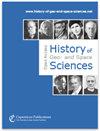Evolution of the Pakistan Space Weather Centre (PSWC)
IF 0.4
4区 哲学
Q4 GEOSCIENCES, MULTIDISCIPLINARY
引用次数: 6
Abstract
Abstract. This work focuses on the progress of space weather monitoring in Pakistan. Pakistan's first geomagnetic observatory was established in Quetta in 1953. However, the beginning of what we would now call space weather services on a formal level took place in 1971, when the national space agency, the Pakistan Space and Upper Atmosphere Research Commission (SUPARCO), established the country's first ionospheric station. Later, in 1983, a geomagnetic observatory was set up in Karachi with the aim of providing high frequency (HF) support and geomagnetic storm alerts to relevant users. With the progression of time, nations began to prioritize space weather monitoring to ensure the safety and security of technological assets. Therefore, it was considered imperative to upgrade the array of instruments in order to maintain the reliability of operations and the efficient utilization of data to contribute to research at local, regional and global scales. Pakistan has recently established a dedicated space weather monitoring facility known as the Pakistan Space Weather Centre (PSWC). This paper describes the historic evolution of space weather infrastructure in Pakistan and the current contribution of the PSWC.巴基斯坦空间气象中心的发展
摘要这项工作的重点是巴基斯坦空间天气监测的进展。巴基斯坦第一个地磁观测站于1953年在奎达建立。然而,我们现在所说的正式层面的空间气象服务是在1971年开始的,当时国家航天局巴基斯坦空间和高层大气研究委员会(SUPARCO)建立了该国第一个电离层站。后来,在1983年,在卡拉奇建立了一个地磁观测站,目的是向有关用户提供高频支持和地磁风暴警报。随着时间的推移,各国开始优先考虑空间天气监测,以确保技术资产的安全和保障。因此,人们认为必须改进一系列仪器,以保持业务的可靠性和有效利用数据,为地方、区域和全球范围的研究作出贡献。巴基斯坦最近建立了一个专门的空间天气监测设施,称为巴基斯坦空间天气中心。本文介绍了巴基斯坦空间气象基础设施的历史演变和PSWC目前的贡献。
本文章由计算机程序翻译,如有差异,请以英文原文为准。
求助全文
约1分钟内获得全文
求助全文
来源期刊

History of Geo- and Space Sciences
GEOSCIENCES, MULTIDISCIPLINARY-HISTORY & PHILOSOPHY OF SCIENCE
CiteScore
1.50
自引率
33.30%
发文量
10
审稿时长
50 weeks
期刊介绍:
The scope of History of Geo- and Space Sciences (HGSS) is to document historical facts and knowledge and to improve awareness of the history of geoscience. The knowledge of the development of geosciences and their experimental methods and theories in the past can improve our current understanding and may stimulate current research. It is encouraging for young scientists to read biographical material of historical figures in their research area. It is important as well to learn that history of science is an integrated part of the ongoing research in their research area. Another important aim of the journal is the association of historical retrospective and current research.
 求助内容:
求助内容: 应助结果提醒方式:
应助结果提醒方式:


